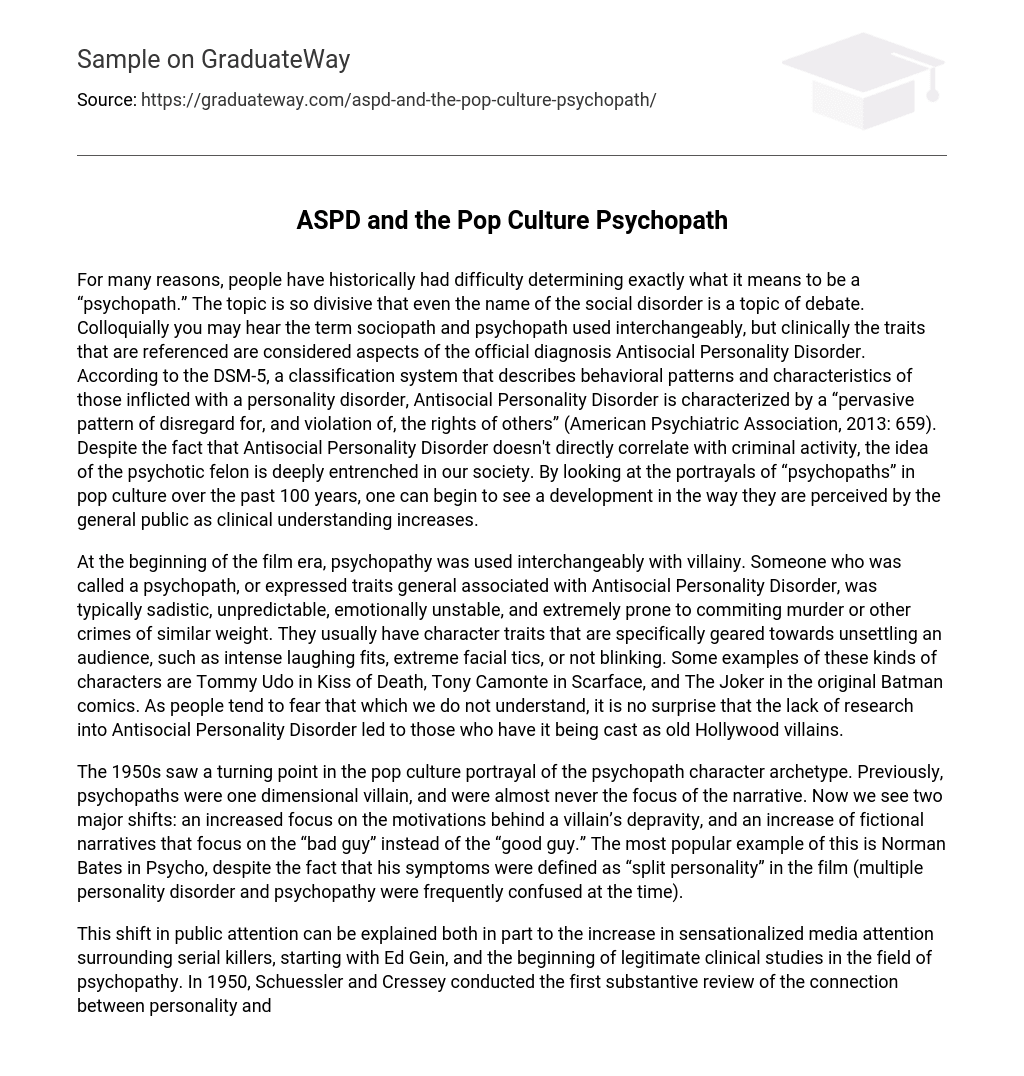For many reasons, people have historically had difficulty determining exactly what it means to be a “psychopath.” The topic is so divisive that even the name of the social disorder is a topic of debate. Colloquially you may hear the term sociopath and psychopath used interchangeably, but clinically the traits that are referenced are considered aspects of the official diagnosis Antisocial Personality Disorder. According to the DSM-5, a classification system that describes behavioral patterns and characteristics of those inflicted with a personality disorder, Antisocial Personality Disorder is characterized by a “pervasive pattern of disregard for, and violation of, the rights of others” (American Psychiatric Association, 2013: 659). Despite the fact that Antisocial Personality Disorder doesn’t directly correlate with criminal activity, the idea of the psychotic felon is deeply entrenched in our society. By looking at the portrayals of “psychopaths” in pop culture over the past 100 years, one can begin to see a development in the way they are perceived by the general public as clinical understanding increases.
At the beginning of the film era, psychopathy was used interchangeably with villainy. Someone who was called a psychopath, or expressed traits general associated with Antisocial Personality Disorder, was typically sadistic, unpredictable, emotionally unstable, and extremely prone to commiting murder or other crimes of similar weight. They usually have character traits that are specifically geared towards unsettling an audience, such as intense laughing fits, extreme facial tics, or not blinking. Some examples of these kinds of characters are Tommy Udo in Kiss of Death, Tony Camonte in Scarface, and The Joker in the original Batman comics. As people tend to fear that which we do not understand, it is no surprise that the lack of research into Antisocial Personality Disorder led to those who have it being cast as old Hollywood villains.
The 1950s saw a turning point in the pop culture portrayal of the psychopath character archetype. Previously, psychopaths were one dimensional villain, and were almost never the focus of the narrative. Now we see two major shifts: an increased focus on the motivations behind a villain’s depravity, and an increase of fictional narratives that focus on the “bad guy” instead of the “good guy.” The most popular example of this is Norman Bates in Psycho, despite the fact that his symptoms were defined as “split personality” in the film (multiple personality disorder and psychopathy were frequently confused at the time).
This shift in public attention can be explained both in part to the increase in sensationalized media attention surrounding serial killers, starting with Ed Gein, and the beginning of legitimate clinical studies in the field of psychopathy. In 1950, Schuessler and Cressey conducted the first substantive review of the connection between personality and crime. Amongst the 113 studies that were reviewed, they saw that 42% of them demonstrated a difference in personalities of offenders and non-offenders. This was a rudimentary introduction in the topic of Antisocial Personality Disorder, but it laid the foundation for more sophisticated studies later on, such as Waldo and Dinitz’s in 1967, and Tennenbaum’s from 1966 to 1975.
The next major shift in pop culture portrayals of psychopaths occurred in the late 20th century and left us with what we generally think of when we refer to the common psychopath in this day and age. The shift is primarily defined by the change from psychopaths being violent criminals of low intelligence, to being sophisticated, brilliant criminal masterminds. In addition, Hollywood digested the public fervor for the concept of psychopaths, and responded with sympathetic character portrayals, and even giving psychopathic traits to the heroes of the story. Some examples of such characters are the charismatic Dr. Hannibal Lecter and Patrick Bateman from Silence of the Lambs and American Psycho respectively, and the well-loved Dr. Gregory House from House M.D., and Dexter Morgan from Dexter. In the TV show Sherlock, the titular character even defines himself as a “high functional sociopath,” which is clearly viewed as being a positive attribute of his personality.
This shift in public sympathies almost directly correlates with one of the most important studies in the field of psychopathy to date: Gottfredson and Hirschi’s “A General Theory of Crime,” published in 1990. This study posited a direct correlation between criminal activity and low self-control. It placed the focus of criminal activity into a person’s environmental circumstances, rather than their personality alone. This, along with Hervey Cleckley’s research into the definition of a psychopath, raised an important distinction in the categorization of Antisocial Personality Disorder: psychopathy does not necessarily indicate criminal inclinations. This leaves us with a new character archetype: a person who is ambitious, aloof, and highly intelligent, but uses their dubious “powers” for good. In other words, the perfectly packaged antihero; someone who is mysterious, intriguing, and leaves you wanting more.
In almost all cases, increased knowledge of a topic decreases the stigmatization surrounding it. It is clear in the evolution of pop culture portrayals of psychopaths that this topic is no different. This could be considered a positive social shift, as those with Antisocial Personality Disorder aren’t being automatically ostracized for crimes they haven’t even committed, but it also means that people like Jeffrey Dahmer and Charles Manson are being martyred and romanticized by many people. Ultimately, the long-term impact of this pop culture movement is yet to be seen.





